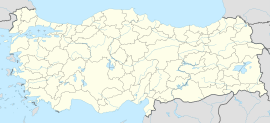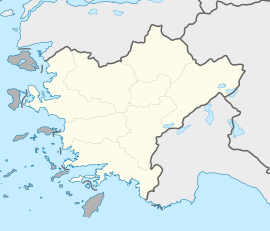Turgutlu, also known as Kasaba (Cassaba or Casaba) is a municipality and district of Manisa Province, Turkey.[2] Its area is 549 km2,[3] and its population is 175,401 (2022).[1] Its elevation is 68 m (223 ft).
Turgutlu | |
|---|---|
District and municipality | |
 Central park in Turgutlu | |
 Map showing Turgutlu District in Manisa Province | |
| Coordinates: 38°30′N 27°42′E / 38.500°N 27.700°E | |
| Country | Turkey |
| Province | Manisa |
| Government | |
| • Mayor | Çetin Akın (CHP) |
Area | 549 km2 (212 sq mi) |
| Elevation | 68 m (223 ft) |
| Population (2022)[1] | 175,401 |
| • Density | 320/km2 (830/sq mi) |
| Time zone | UTC+3 (TRT) |
| Area code | 0236 |
| Website | www |
The name derives from the name of the Turkish clan of "Turghudlu" (also cited as "Turgut" or "Turgutoğlu"), recorded as having provided the main support to the Beylik of Karaman during their time of existence [4] and mentioned in historical records as an important political entity as late as the 18th century Iran. Their settlement in Turgutlu region is thought to have taken place some time in the 15th century at the same time as the Ottoman unification of Anatolia which resulted in the demise of Karamanids. That nearby Manisa was the center where Ottoman shahzades (crown princes) received their education must have placed the clan once again in a non-negligible position in their relations this time with the Ottoman dynasty.
The term Casaba for melons derived from the name of the city, an echo of its 18th-19th century past when it was an important regional trade center and hub, located in the middle of a fertile alluvial plain and with access to outside markets through nearby İzmir.
General features
editTurgutlu center is at a distance of 31 km to Manisa, to which it depends administratively, and at a distance of 50 km to the international portuary center of İzmir. Its closeness to these two metropolitan centers both of which have a deep and rooted history marked Turgutlu's destiny since its foundation in the 15th century. Today, the intense industrial activities in the even nearer İzmir district of Kemalpaşa also find considerable repercussions in Turgutlu, which itself has a reputation of being one of the prominent centers of soil industry in Turkey.
There are 44 primary schools and 14 schools providing intermediate education in Turgutlu district, bringing together 1,189 teachers and 28,767 students. There is also a higher professional school, a department of Celal Bayar University, at the district center. The state hospital at Turgutlu center has a bed capacity of 250, and there are also eleven health centers, all corresponding to a health professionals corpus of 370, 135 of whom are doctors.
At fifty-six per cent, Turgutlu district has the highest proportion of agricultural lands across Manisa Province districts in its territory, while the forest lands covering a total area close to twenty thousand hectares, are also of considerable extent.
Composition
editThere are 61 neighbourhoods in Turgutlu District:[5]
- Acarlar
- Akçapınar
- Akköy
- Albayrak
- Altay
- Aşağıbozkır
- Atatürk
- Avşar
- Ayvacık
- Baktırlı
- Bozkır
- Bozkurt
- Çampınar
- Çatalköprü
- Çepnibektaş
- Çepnidere
- Çıkrıkçı
- Cumhuriyet
- Dağyeniköy
- Dalbahçe
- Derbent
- Ergenekon
- Gökgedik
- Güney
- Hacıisalar
- Irlamaz
- İstasyonaltı
- İstiklal
- İzzettin
- Kabaçınar
- Karaköy
- Karaoluk
- Kayrak
- Kurtuluş
- Kurudere
- Kuşlar
- Musacalı
- Musalaryeniköy
- Mustafa Kemal
- Ören
- Osmancık
- Özyurt
- Sarıbey
- Şehitler
- Selvilitepe
- Sinirli
- Sivrice
- Subaşı
- Temrek
- Turan
- Turgutlar
- Urganlı
- Yakuplar
- Yayla
- Yedieylül
- Yeni
- Yeniköy
- Yiğitler
- Yıldırım
- Yılmazlar
- Yunusdere
Industry
editReconstructed from scratch as of the 1920s, modern Turgutlu is, in addition to a productive agricultural sector, also an important industrial base structured under a Chamber of Industry founded in 1926. It is home to the production installations of Tukaş, one of the most prominent producers of canned food (principally vegetables and fruits) in Turkey, as well as to BMC (Turkey), the Turkish branch of the motor vehicle giant BMC, active principally in commercial vehicles, trucks and buses. The town's industrial sector as a whole displays as high a degree of dynamism as its agricultural production, with many small- and medium-sized enterprises active in various fields. Also Seramiksan, one of the leading tile manufacturers of Turkey specialized in the production of ceramic wall and floor tiles, glazed and technical porcelain tiles, has their production installations in Turgutlu.
Experimental mining of nickel laterites by using a heap leach process in Mount Çal near Turgutlu started in 2005 by a Turkish subsidiary of European Nickel PLC. The reserves are estimated to be 33 million tons of ore at 1.13% Nickel and 0.08% cobalt content. The planned development of a nickel mine and processing plant could deeply influence the district's economy with a potential to become one of the most important investments in Turkey's Aegean Region.
History
editİzmir-Kasaba Railway
editThe town was an important regional trade center and hub already since the 18th century. It acquired further importance once it became the first terminus of the 93 km. Smyrna Cassaba Railway whose construction was started from İzmir in 1863 and which arrived in Kasaba in 1866. This railway was the third started within the territory of the Ottoman Empire at the time and the first finished within the present-day territory of Turkey.[6]
Instead of being laid along the direct route eastwards from İzmir to Turgutlu, about fifty kilometers in length, the line built drew a wide arc advancing first to the north-west from İzmir, through its Karşıyaka suburb to whose foundation it contributed greatly, and curves eastwards only from Menemen on, crossing the former sanjak and the present-day province center of Manisa to join Turgutlu from the north. Belkahve Pass between Mount Nif and Mount Sipylus on the direct road from İzmir and Turgutlu must have been judged too difficult for a track at the time. This railway was later extended further eastwards reaching a total length exceeding seven hundred kilometers but the operating company preserved the name Smyrna Cassaba. The first concession under the name was granted to a locally based English entrepreneur named Edward Price, who founded the company and built the line, and sold it in 1893 to the Franco-Belgian group Compagnie Internationale des Wagons-Lits, which extended it.[7] The line was nationalized in 1934 by the young Republic of Turkey in the frame of a general move started in the 1920s regarding Turkey's railways.
From 1867 until 1922, Turgutlu was part of the Aydin Vilayet of the Ottoman Empire. The town was made into a kaza (district center) in 1868. During the final years of the Ottoman Empire, Kasaba was already a large town whose population well exceeded ten thousand people. During the 1910s, Kasaba was recorded by sources such as G. Sotiriadis (1918) and S. Anagiostopoulou (1997) as having a Greek population averaging at around one sixth of the total, between 3500 and 6000, in a subdistrict aggregate of thirty-five thousand and a center town population of around fourteen thousand.[8]
Turgutlu during the Turkish War of Independence
editTurgutlu remained under Greek occupation between 29 May 1919 and 7 September 1922. The most bitter blow suffered by the town has been the fire started by the retreating Greek army on 5 September 1922, and which has lasted for two whole days, destroying 6127 buildings in a total of 6328, the historic Pasha Mosque, and the 20000 manuscript books preserved in the town library, as well as at the very least a thousand human lives (based on the corpses that could be counted). The survival of another historical monument, the Hacı Zeynel Mosque and of the surrounding small agglomeration is locally still interpreted as divine intervention.[9] According to a number of sources, the retreating Greek army carried out a scorched-earth policy while fleeing from Anatolia during the final phase of the war.[10] According to a report of the Consul Park 90% of the buildings of the town were destroyed, as result of organized operations accompanied by several atrocities.[11]
Notable people
edit- Hilmi Özkök (born 1940), general, the former Chief of Staff of the Turkish Armed Forces
- Alberto Hemsi (1898–1975), Jewish composer
- Alex Manoogian (1901-1996), Armenian-American industrial engineer, businessman
References
edit- ^ a b "Address-based population registration system (ADNKS) results dated 31 December 2022, Favorite Reports" (XLS). TÜİK. Retrieved 12 July 2023.
- ^ Büyükşehir İlçe Belediyesi, Turkey Civil Administration Departments Inventory. Retrieved 12 July 2023.
- ^ "İl ve İlçe Yüz ölçümleri". General Directorate of Mapping. Retrieved 12 July 2023.
- ^ Colin Imber (1990). The Ottoman Empire, 1300-1481. Isis Press, Istanbul. p. 190. ISBN 978-975-428-015-9.
- ^ Mahalle, Turkey Civil Administration Departments Inventory. Retrieved 19 September 2023.
- ^ A short line built in Dobruja (now in Romania) was started and finished earlier, and İzmir-Aydın railway was started earlier in 1856 but finished a year after Smyrna Cassaba Railway in 1867.
- ^ Roth, Ralf; Dinhobl, Günter, eds. (2008). Across the Borders: Financing the World's Railways in the Nineteenth and Twentieth Centuries. Ashgate Publishing. ISBN 978-0-7546-6029-3.
- ^ The relayer of the demographic data according to Greek sources, the researcher Georgios Nakratzas adds as a personal note that his own maternal family who were from Kasaba's Hamzabeyli village were at the origin economic migrants who had immigrated to Anatolia in the 1770s from Mani Peninsula in mainland Greece.
- ^ James Loder Park, the U.S. Vice-Consul in Istanbul at the time, who toured much of the devastated area immediately after the Greek evacuation, described the situation in the western Anatolian cities and towns he has seen, as follows: "Manisa...almost completely wiped out by fire (...). Cassaba (present day Turgutlu) was a town of 40,000 souls, 3,000 of whom were non-Moslems. Of these 37,000 Turks only 6,000 could be accounted for among the living, while 1,000 Turks were known to have been shot or burned to death. Of the 2,000 buildings that constituted the city, only 200 remained standing. Ample testimony was available to the effect that the city was systematically destroyed (...). Kerosene and gasoline were freely used to make the destruction more certain, rapid and complete. (...) The percentages of buildings destroyed in (...) Manisa [was] 90 percent, [in] Cassaba (Turgutlu) 90 percent, [in] Alaşehir 70 percent, [in] Salihli 65 percent. The burning of these cities was not desultory, nor intermittent, nor accidental, but well planned and thoroughly organized. (...) Without complete figures, (...) it may safely be surmised that 'atrocities' [consisting of murder, torture and rape] committed by retiring Greeks numbered well into thousands in the four cities under consideration."
- ^ Sydney Nettleton Fisher, The Middle East: a history, New York: Alfred A. Knopf, 1969, p. 386
- ^ U.S. Vice-Consul James Loder Park to Secretary of State, Smyrna, 11 April 1923. US archives US767.68116/34

